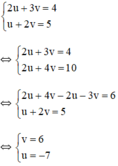Giải hệ phương trình 1 x − x y = x 2 + x y − 2 y 2 ( 1 ) x + 3 − y 1 + x 2 + 3 x = 3 ( 2 )
Hãy nhập câu hỏi của bạn vào đây, nếu là tài khoản VIP, bạn sẽ được ưu tiên trả lời.


Ta có hệ : \(\hept{\begin{cases}x^2+y^2=\frac{1}{2}\\\left(x+y\right)^3+\left(x-y\right)^3=1\end{cases}}\) \(\Leftrightarrow\hept{\begin{cases}2x^2+2y^2=1\\2x^3+6xy^2=1\end{cases}\Leftrightarrow}\hept{\begin{cases}2y^2=1-2x^2\left(1\right)\\2x^3+6xy^2=1\left(2\right)\end{cases}}\)
Dễ thấy \(y=0\) không là nghiệm nên thế (1) và (2) ta có : \(2x^3+3.x.\left(1-2x^2\right)=1\)
\(\Leftrightarrow4x^3-3x+1=0\)
\(\Leftrightarrow\left(x+1\right)\left(2x-1\right)^2=0\)
\(\Leftrightarrow\orbr{\begin{cases}x=-1\\x=\frac{1}{2}\end{cases}}\)
+) Với \(x=-1\) thì ta có : \(\hept{\begin{cases}\left(-1\right)^2+y^2=\frac{1}{2}\\\left(-1+y\right)^3+\left(-1-y\right)^3=1\end{cases}}\) ( Vô nghiệm )
+) Với \(x=\frac{1}{2}\) thì ta có : \(\left(\frac{1}{2}\right)^2+y^2=\frac{1}{2}\Leftrightarrow y=\pm\frac{1}{2}\). Thỏa mãn hệ phương trình.
Vậy hệ pt có 2 nghiệm \(\left(x,y\right)=\left\{\left(\frac{1}{2};-\frac{1}{2}\right),\left(\frac{1}{2},\frac{1}{2}\right)\right\}\)

ĐKXĐ: x<>2 và y>=-1
\(\left\{{}\begin{matrix}\dfrac{1}{x-2}-2\sqrt{y+1}=-4\\\dfrac{2}{x-2}+\sqrt{y+1}=7\end{matrix}\right.\)
=>\(\left\{{}\begin{matrix}\dfrac{2}{x-2}-4\sqrt{y+1}=-8\\\dfrac{2}{x-2}+\sqrt{y+1}=7\end{matrix}\right.\)
=>\(\left\{{}\begin{matrix}-5\sqrt{y+1}=-15\\\dfrac{2}{x-2}+\sqrt{y+1}=7\end{matrix}\right.\Leftrightarrow\left\{{}\begin{matrix}\sqrt{y+1}=3\\\dfrac{2}{x-2}=7-3=4\end{matrix}\right.\)
=>\(\left\{{}\begin{matrix}y+1=9\\x-2=\dfrac{1}{2}\end{matrix}\right.\Leftrightarrow\left\{{}\begin{matrix}y=8\\x=\dfrac{5}{2}\end{matrix}\right.\left(nhận\right)\)

Bài toán này có hai cách giải:
Cách 1: Thu gọn từng phương trình ta sẽ thu được phương trình bậc nhất hai ẩn x và y.
Cách 2: Đặt ẩn phụ.
Cách 1:

 (hệ số của y bằng nhau nên ta trừ từng vế hai phương trình)
(hệ số của y bằng nhau nên ta trừ từng vế hai phương trình)

Vậy hệ phương trình có nghiệm duy nhất 

(Nhân hai vế pt 1 với 2; pt 2 với 3 để hệ số của y đối nhau)
 (Hệ số của y đối nhau nên ta cộng từng vế của hai pt)
(Hệ số của y đối nhau nên ta cộng từng vế của hai pt)

Vậy hệ phương trình có nghiệm duy nhất (1; -1).
Cách 2:
a) Đặt x + y = u và x – y = v (*)
Khi đó hệ phương trình trở thành

Thay u = -7 và v = 6 vào (*) ta được hệ phương trình:

Vậy hệ phương trình có nghiệm 
b) Đặt x – 2 = u và y + 1 = v.
Khi đó hệ phương trình trở thành :

+ u = -1 ⇒ x – 2 = -1 ⇒ x = 1.
+ v = 0 ⇒ y + 1 = 0 ⇒ y = -1.
Vậy hệ phương trình có nghiệm (1; -1).

c) \(\left\{{}\begin{matrix}2\left(x-2\right)+3\left(1+y\right)=2\\3\left(x-2\right)-2\left(1+y\right)=-3\end{matrix}\right.\)
\(\Leftrightarrow\left\{{}\begin{matrix}6\left(x-2\right)+9\left(1+y\right)=6\\6\left(x-2\right)-4\left(1+y\right)=-6\end{matrix}\right.\)
\(\Leftrightarrow\left\{{}\begin{matrix}13\left(1+y\right)=12\\2\left(x-2\right)+3\left(1+y\right)=2\end{matrix}\right.\)
\(\Leftrightarrow\left\{{}\begin{matrix}x=\dfrac{21}{13}\\y=-\dfrac{1}{13}\end{matrix}\right.\)
d) \(\left\{{}\begin{matrix}\left(x-5\right)\left(y-2\right)=\left(x+2\right)\left(y-1\right)\\\left(x-4\right)\left(y+7\right)=\left(x-3\right)\left(y+4\right)\end{matrix}\right.\)
\(\Leftrightarrow\left\{{}\begin{matrix}xy-2x-5y+10=xy-x+2y-2\\xy+7x-4y-28=xy+4x-3y-12\end{matrix}\right.\)
\(\Leftrightarrow\left\{{}\begin{matrix}-x-7y=-12\\3x-y=16\end{matrix}\right.\) \(\Leftrightarrow\left\{{}\begin{matrix}-x-7y=-12\\21x-7y=112\end{matrix}\right.\)
\(\Leftrightarrow\left\{{}\begin{matrix}22x=124\\3x-y=16\end{matrix}\right.\) \(\Leftrightarrow\left\{{}\begin{matrix}x=\dfrac{62}{11}\\y=\dfrac{10}{11}\end{matrix}\right.\)

** Bạn lưu ý lần sau viết đề bằng công thức toán để được hỗ trợ tốt hơn.
Lời giải:
\(\Leftrightarrow \left\{\begin{matrix}
x^2(x^2-2y)=1\\
x^2-2y=2-x^2+y^2\end{matrix}\right.\)
\(\Rightarrow x^2(2-x^2+y^2)=1\)
\(\Leftrightarrow x^2y^2-(x^4-2x^2+1)=0\Leftrightarrow (xy)^2-(x^2-1)^2=0\)
\(\Leftrightarrow xy=x^2-1\) hoặc \(xy=1-x^2\)
TH1: $x^2-1=xy$
Thay vô pt $(1)$: $(x^2-1)(x^2+1)-2x^2y=0$
$\Leftrightarrow xy(xy+2)-2x^2y=0$
$\Leftrightarrow xy(xy+2-2x)=0$
$\Leftrightarrow xy(x^2-1+2-2x)=0$
$\Leftrightarrow xy(x-1)^2=0$
Nếu $x=0$ thì vô lý
Nếu $y=0$ thì $x=\pm 1$
Nếu $(x-1)^2=0\Rightarrow x=1\Rightarrow y=0$
TH2: Tương tự
Vậy $(x,y)=(\pm 1, 0)$

`x-y=2<=>x=y+2` thay vào trên
`=>m(y+2)+2y=m+1`
`<=>y(m+2)=m+1-2m`
`<=>y(m+2)=1-2m`
Để hpt có nghiệm duy nhất
`=>m+2 ne 0<=>m ne -2`
`=>y=(1-2m)/(m+2)`
`=>x=y+2=5/(m+2)`
`xy=x+y+2`
`<=>(5-10m)/(m+2)=(6-2m)/(m+2)+2`
`<=>(5-10m)/(m+2)=10/(m+2)`
`<=>5-10m=10`
`<=>10m=-5`
`<=>m=-1/2(tm)`
Vậy `m=-1/2` thì HPT có nghiệm duy nhât `xy=x+y+2`
`a)m=2`
$\begin{cases}2x+2y=3\\x-y=2\end{cases}$
`<=>` $\begin{cases}2x+2y=3\\2x-2y=4\end{cases}$
`<=>` $\begin{cases}4y=-1\\x=y+2\end{cases}$
`<=>` $\begin{cases}y=-\dfrac14\\y=\dfrac74\end{cases}$
Vậy m=2 thì `(x,y)=(7/4,-1/4)`

e: \(\left\{{}\begin{matrix}\dfrac{1}{x}-\dfrac{1}{y}=1\\\dfrac{3}{x}+\dfrac{4}{y}=5\end{matrix}\right.\Leftrightarrow\left\{{}\begin{matrix}\dfrac{3}{x}-\dfrac{3}{y}=3\\\dfrac{3}{x}+\dfrac{4}{y}=5\end{matrix}\right.\)
\(\Leftrightarrow\left\{{}\begin{matrix}\dfrac{-7}{y}=-2\\\dfrac{1}{x}-\dfrac{1}{y}=1\end{matrix}\right.\Leftrightarrow\left\{{}\begin{matrix}y=\dfrac{7}{2}\\\dfrac{1}{x}=1+\dfrac{2}{7}=\dfrac{9}{7}\end{matrix}\right.\Leftrightarrow\left\{{}\begin{matrix}y=\dfrac{7}{2}\\x=\dfrac{7}{9}\end{matrix}\right.\)

1. \(2x^2-3x-5=0\)
\(\Leftrightarrow\left(2x-5\right)\left(x+1\right)=0\)
\(\Leftrightarrow\orbr{\begin{cases}2x-5=0\\x+1=0\end{cases}}\)
\(\Leftrightarrow\orbr{\begin{cases}x=2,5\\x=-1\end{cases}}\)
Vậy tập ngiệm của phương trình là \(S=\left\{2,5;-1\right\}\)
2x2-3x-5=0
2x2+2x-5x-5=0
2x(x+1)+5(x+1)=0
(x+1)(2x+5)=0
TH1 x+1=0 <=>x=-1
TH2 2x+5=0<=>2x=-5<=>x=-5/2
2. ta có:
2(x-2y)-(2x+y)=-1.2-8
2x-4y-2x-y=-2-8
-5y=-10
y=2
thay vào
x-2y=-1 ( với y=2)
<=> x-2.2=-1
x-4=-1
x=3

\(\left\{{}\begin{matrix}\left(x-5\right)\left(y-2\right)=\left(x+2\right)\left(y-1\right)\\\left(x-4\right)\left(y+7\right)=\left(x-3\right)\left(y+4\right)\end{matrix}\right.\)
\(\Leftrightarrow\left\{{}\begin{matrix}xy-2x-5y+10=xy-x+2y-2\\xy+7x-4y-28=xy+4x-3y-12\end{matrix}\right.\)
\(\Leftrightarrow\left\{{}\begin{matrix}x+7y=12\\3x-y=16\end{matrix}\right.\) \(\Leftrightarrow\left\{{}\begin{matrix}3x+21y=36\\3x-y=16\end{matrix}\right.\)
\(\Leftrightarrow\left\{{}\begin{matrix}22y=20\\x+7y=12\end{matrix}\right.\) \(\Leftrightarrow\left\{{}\begin{matrix}x=\dfrac{62}{11}\\y=\dfrac{10}{11}\end{matrix}\right.\)

1 x − x y = x 2 + x y − 2 y 2 ( 1 ) x + 3 − y 1 + x 2 + 3 x = 3 ( 2 )
Điều kiện: x > 0 y > 0 x + 3 ≥ 0 x 2 + 3 x ≥ 0 ⇔ x > 0 y > 0
( 1 ) ⇔ y − x y x = ( x − y ) ( x + 2 y ) ⇔ ( x − y ) x + 2 y + 1 y x = 0 ⇔ x = y do x + 2 y + 1 y x > 0 , ∀ x , y > 0
Thay y = x vào phương trình (2) ta được:
( x + 3 − x ) ( 1 + x 2 + 3 x ) = 3 ⇔ 1 + x 2 + 3 x = 3 x + 3 − x ⇔ 1 + x 2 + 3 x = x + 3 + x ⇔ x + 3 . x − x + 3 − x + 1 = 0 ⇔ ( x + 1 − 1 ) ( x − 1 ) = 0 ⇔ x + 3 = 1 x = 1 ⇔ x = − 2 ( L ) x = 1 ( t m ) ⇒ x = y = 1
Vậy hệ có nghiệm duy nhất (1;1)